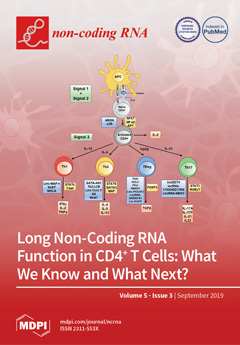Long non-coding RNA (lncRNA) genes encode non-messenger RNAs that lack open reading frames (ORFs) longer than 300 nucleotides, lack evolutionary conservation in their shorter ORFs, and do not belong to any classical non-coding RNA category. LncRNA genes equal, or exceed in number, protein-coding
[...] Read more.
Long non-coding RNA (lncRNA) genes encode non-messenger RNAs that lack open reading frames (ORFs) longer than 300 nucleotides, lack evolutionary conservation in their shorter ORFs, and do not belong to any classical non-coding RNA category. LncRNA genes equal, or exceed in number, protein-coding genes in mammalian genomes. Most mammalian genomes harbor ~20,000 protein-coding genes that give rise to conventional messenger RNA (mRNA) transcripts. These coding genes exhibit sweeping evolutionary conservation in their ORFs. LncRNAs function via different mechanisms, including but not limited to: (1) serving as “enhancer” RNAs regulating nearby coding genes in
cis; (2) functioning as scaffolds to create ribonucleoprotein (RNP) complexes; (3) serving as sponges for microRNAs; (4) acting as ribo-mimics of consensus transcription factor binding sites in genomic DNA; (5) hybridizing to other nucleic acids (mRNAs and genomic DNA); and, rarely, (6) as templates encoding small open reading frames (smORFs) that may encode short proteins. Any given lncRNA may have more than one of these functions. This review focuses on one fascinating case—the growth-arrest-specific (
GAS)-5 gene, encoding a complicated repertoire of alternatively-spliced lncRNA isoforms.
GAS5 is also a host gene of numerous small nucleolar (sno) RNAs, which are processed from its introns. Publications about this lncRNA date back over three decades, covering its role in cell proliferation, cell differentiation, and cancer. The
GAS5 story has drawn in contributions from prominent molecular geneticists who attempted to define its tumor suppressor function in mechanistic terms. The evidence suggests that rodent
Gas5 and human
GAS5 functions may be different, despite the conserved multi-exonic architecture featuring intronic snoRNAs, and positional conservation on syntenic chromosomal regions indicating that the rodent
Gas5 gene is the true ortholog of the
GAS5 gene in man and other apes. There is no single answer to the molecular mechanism of
GAS5 action. Our goal here is to summarize competing, not mutually exclusive, mechanistic explanations of
GAS5 function that have compelling experimental support.
Full article






